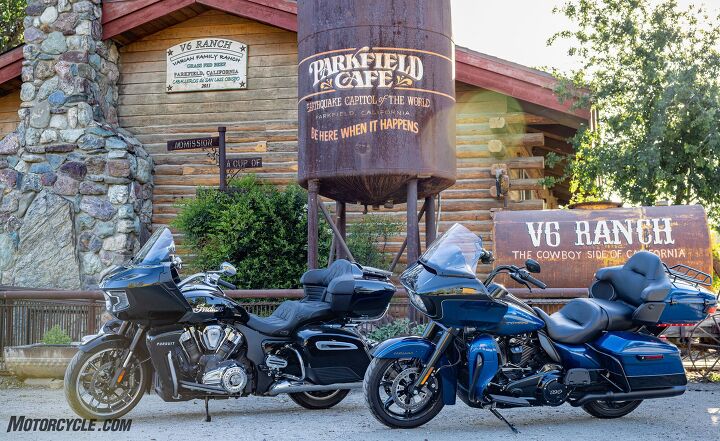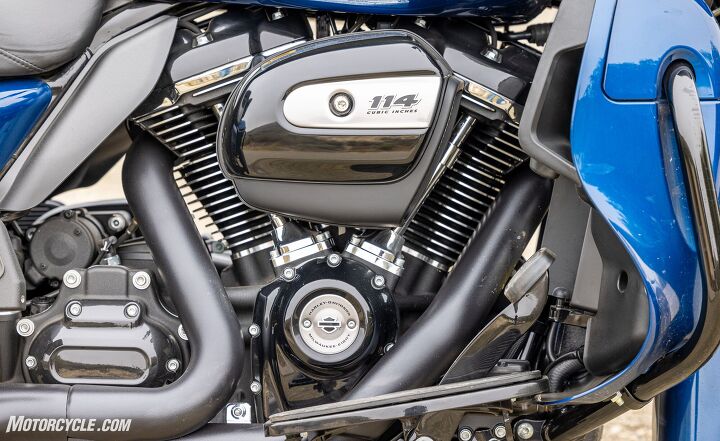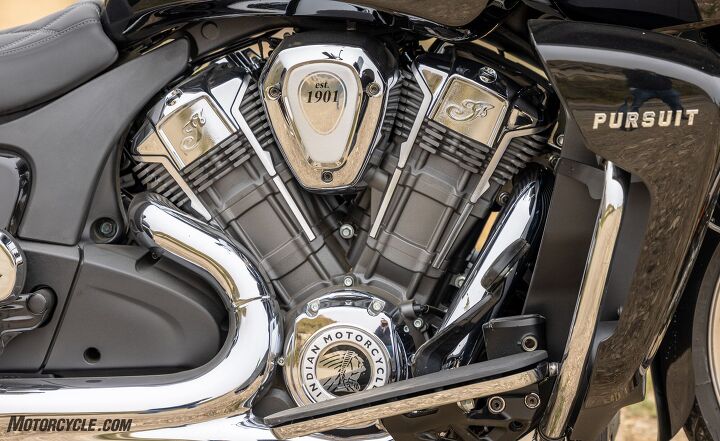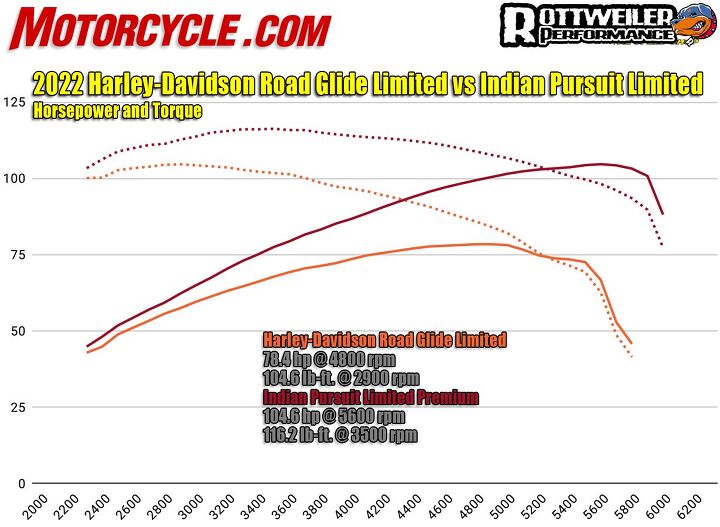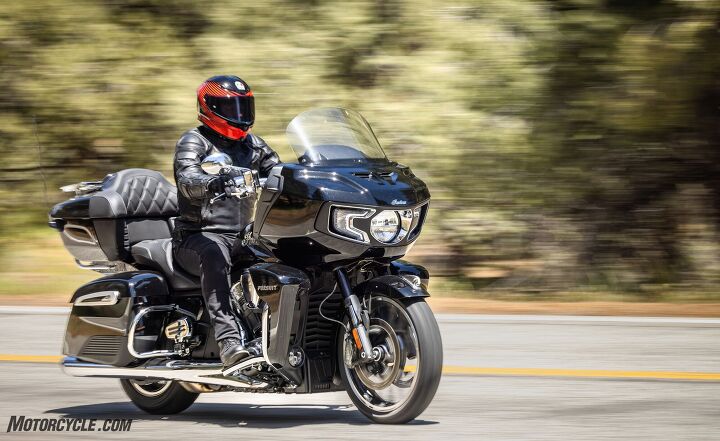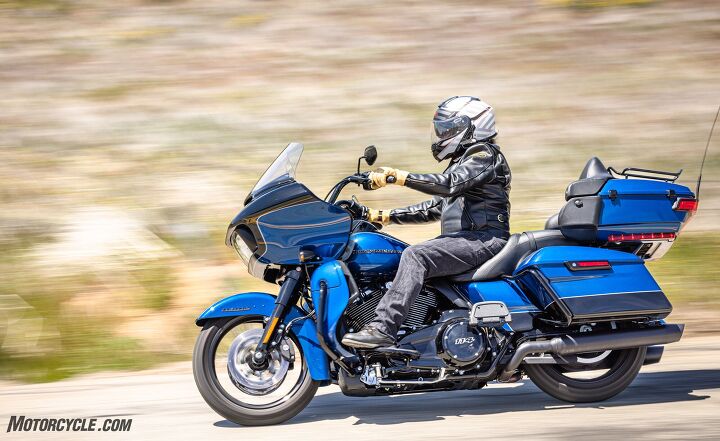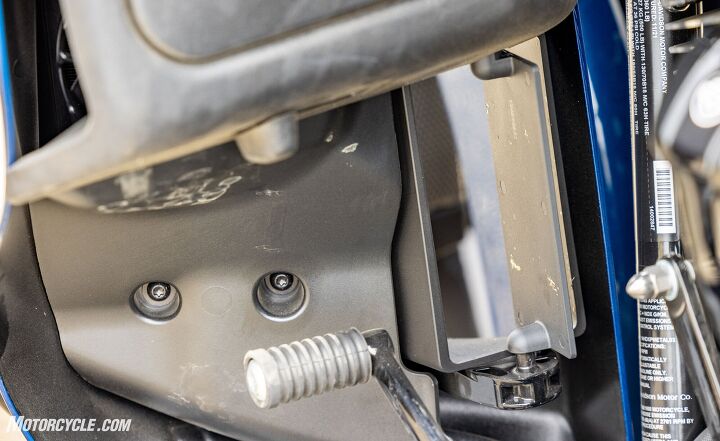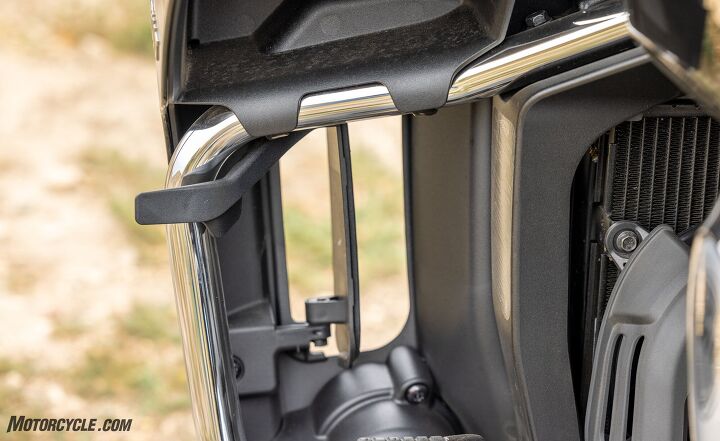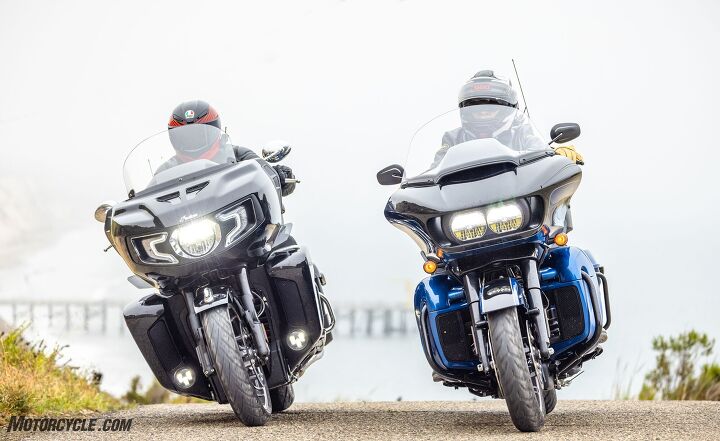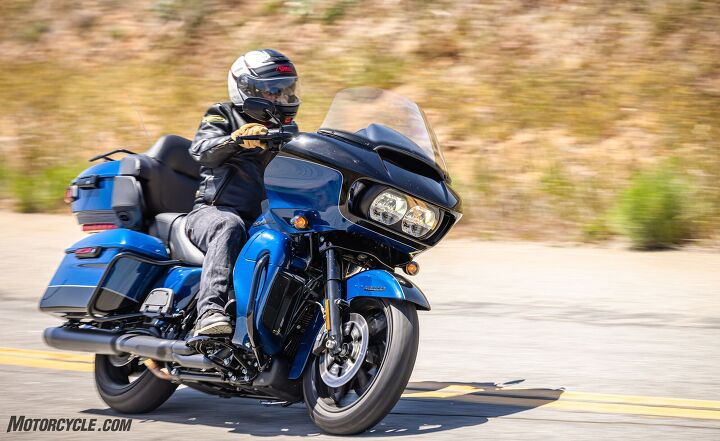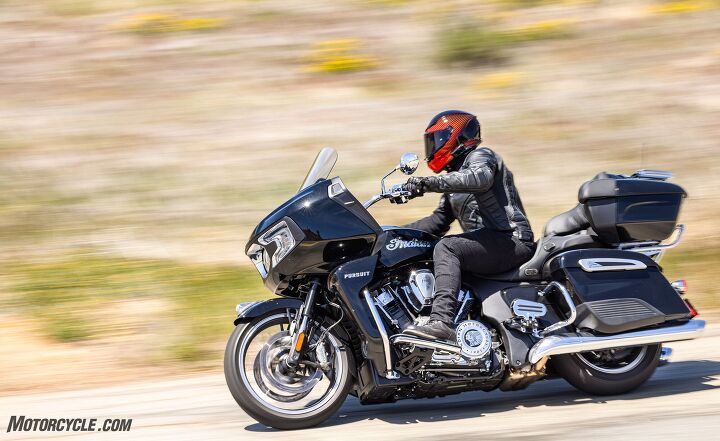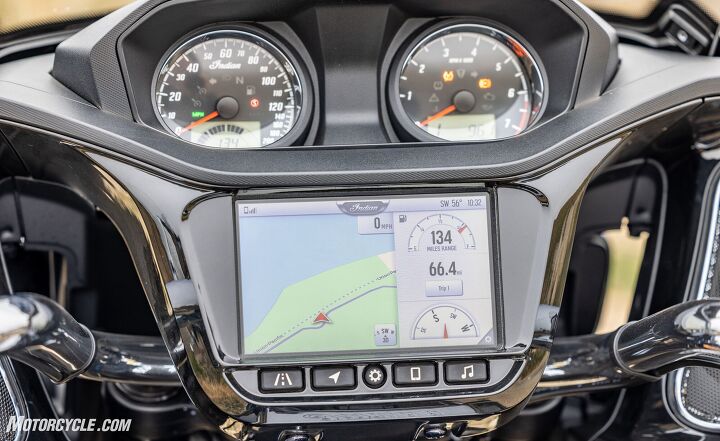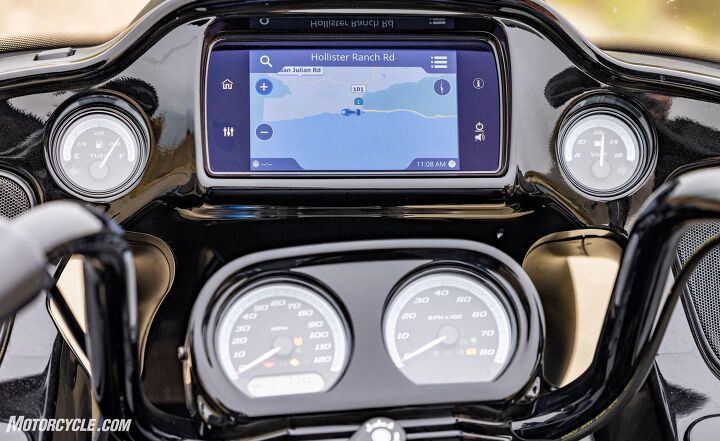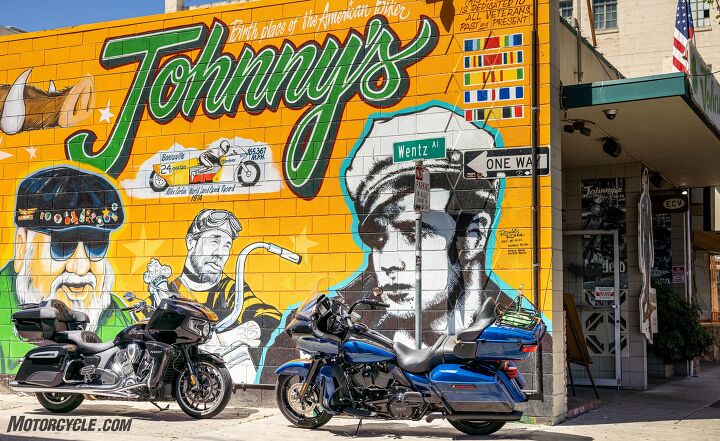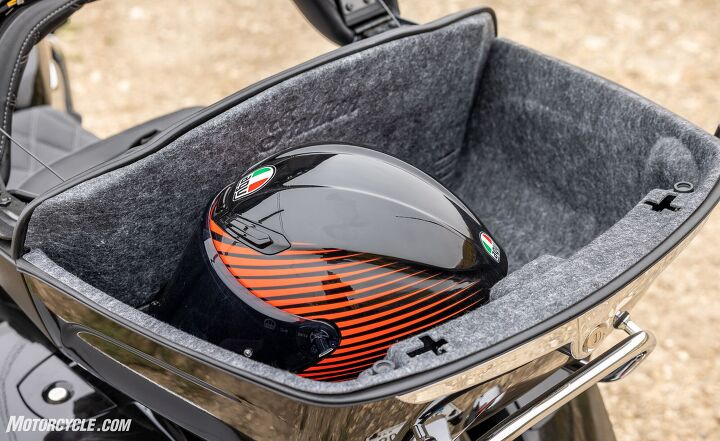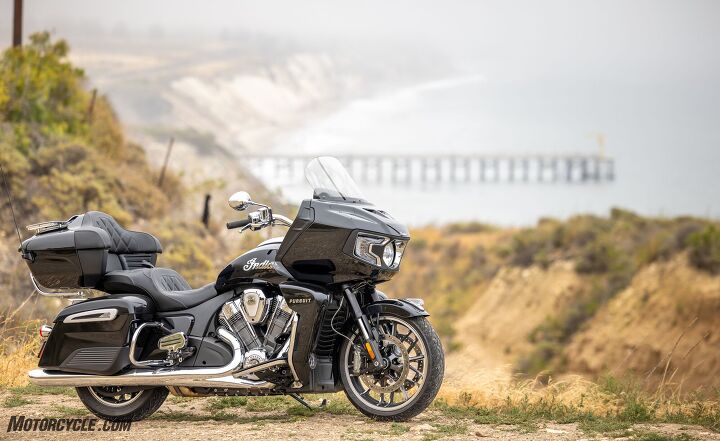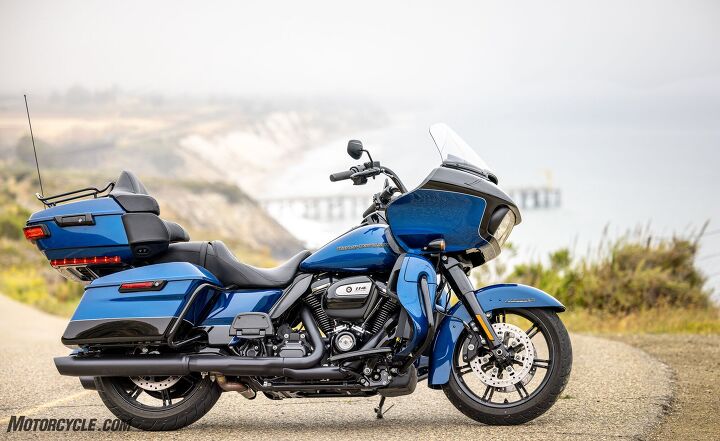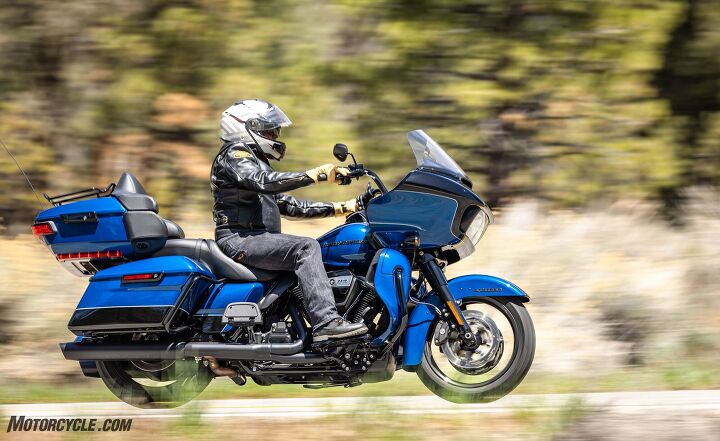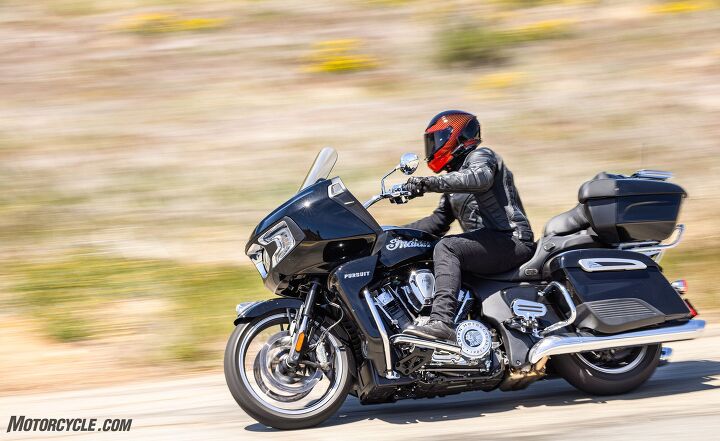Motorsports Racing News & Blog Articles
Showdown: 2022 Harley-Davidson Road Glide Limited vs Indian Pursuit Limited Premium
Who are we to question the motorcycles red-blooded Americans love most? Harley-Davidson sells more Street Glides than it does Road Glide Limiteds (which basically adds the frame-mounted fairing and trunk), but the song remains the same. Indian’s new Pursuit adds the same things to its Challenger – though its fairing was already a frame-mounted design. Who doesn’t want more storage? More closet space? Nobody. And that goes double for people who travel in pairs. In every couple, there’s at least one shoe hound.
Gold Wing and BMW fans will continue to look down their noses, but American-style grand touring has always been a slightly different animal – one that generally covers longer distances at slower speeds than you’ll find on the Continent. True, Honda built the Gold Wing primarily for the USA, but especially the latest version is almost too swoopy for its own good: It’s hard not to speed on the ’Wing, and they actually made it smaller and lighter. WTF? Maybe the bigger problem is that Honda’s never made the slightest effort to make the bike look American. For some people, that’s a problem. Really, Honda’s just smart enough not to try, though it did sell plenty of American-styled Shadow cruisers and things once upon a time.
| 2022 Harley-Davidson Road Glide Limited | ||
|---|---|---|
| + Highs The world is your oyster Tailor-made for people about 5’8″ Amazingly agile for 929 pounds | – Sighs 929 pounds What, no electric windshield? I actually don’t miss central locking, but for $33k we should have it anyway | |
| 2022 Indian Pursuit Limited Premium | ||
|---|---|---|
| + Highs 105 horses at 5600 rpm is 27 more than the other bike, 800 rpm higher Considerably torquier too Premium model’s electronic-adjust Fox shock makes the whole chassis muy classy | – Sighs You need more than four days to figure out how to work everything A tick behind the Harley in fit/finish Even heavier, at 933 lbs… | |
Encroaching into Harley-Davidson territory, though, is exactly what Indian’s been up to ever since Polaris resurrected the name eight years ago, and so now it falls upon us to relive the Harley/Indian wars just as our ancestors did decades ago.
Freedom from Want
Both these bikes are the $33,000 ne plus ultra of their respective manufacturer (excluding your H-D CVOs), bringing to the table just about every touring amenity one could want. You can spend a few thousand more on Indian’s Roadmaster, but that bike’s powered by the older air-cooled Thunderstroke engine instead of the new liquid-cooled 108-inch V-Twin that Indian debuted in its Challenger a couple of years ago. That older 116-inch engine might be a better match-up to the Harley’s 114-inch Milwaukee Eight, but we wanted to ride the Pursuit because it’s new. And in fact, the different engine characteristics between the Indian and Harley really defines them. All else isn’t equal, but it’s close.
The 2022 Indian Pursuits Are Here
Your Indian PowerPlus V-Twin is oversquare, with 4.25-inch pistons swinging through a 3.8-in stroke, making it effectively one slice off a ’60s 427 Chevy. Or Ford.
Redline is 6500 rpm, and our unit made 105 horses at 5600 rpm. Meanwhile, the Harley’s bigger semi liquid-cooled undersquare engine (4.016 in. x 4.5 in.) makes its power lower in the rev band, but considerably less of it: just 78.4 hp at 4800 rpm.
Being of greater displacement, the Harley will make more torque, right? Wrong. The Indian is torquier, too, cranking out 116 pound-feet to the Harley’s 105. But you have to rev the Indian to 3500 rpm to get it, 600 rpm beyond the Harley’s 2900-rpm torque peak.
No big: The Indian’s geared a bit shorter, with a 3.017:1 final-drive ratio in 6th gear to the H-D’s 2.875:1 final-drive gearing. Set the Glide’s cruise control at 80-ish mph, and the tachometer says 3000 rpm.
Do the same on the Indian, and you’re looking at 3100-ish rpm. All you feel on either bike is a faint, far-away rumble. Rolling on the gas from 60 mph in top gear, the Indian winks at the Harley before steadily and progressively pulling away from it. The same thing happens from 80 mph, but faster.
Ryan Adams: Switching the Pursuit into Sport mode lets you experience all the PowerPlus engine has to offer with more immediate throttle response. Rolling on the throttle with these two bikes side-by-side illustrates the dyno chart perfectly and how differently you ride these machines. On the RG Limited, you find yourself short-shifting to keep in the bulk of that low-end torque, whereas if you were to try the same technique on the Pursuit, you’d be missing out on all that intoxicating mid-range power, which is where its mill really shines.
Transcontinental Holistic Missiles
Many discerning buyers of these two won’t care exactly how fast they get up to speed, only how well they swallow great expanses once they get there. We’re happy to report you can’t go wrong on either of these two. With mostly upright ergonomics atop deep-dish bucket seats, with more possible foot placements than Fred Astaire on rubber-isolated floorboards, which allow you to turn the other cheek – sometimes including the passenger floorboards – you really can ride all day.
Off the bat, even though its seat is a skosh lower (the specs say it’s full 2.4 inches lower), the Indian feels like it would fit taller, longer-armed people better. That’s mostly because its grips are an inch or two further forward than the Harley’s, which has 5’8” persons like Ryan Adams and me having to lean forward a tad.
The Harley’s mini ape-hanger brings the grips more rearward and looks like it would offer a greater degree of adjustment, too. The Harley’s whole rider triangle feels custom-made for people about my size in fact, and I have heard complaints from taller people who feel locked in place, since both bikes’ seats have big bolsters to rest the lower back against. (Why no built-in massagers?)
Being too small is probably better than being too big, because it barely matters when you can take a hand off the bar thanks to electronic cruise control. If you’re looking for reasons not to buy, maybe adaptive cc and blind-spot detection, like on the latest Ducatis and BMWs, will be along shortly? Otherwise, these two are packed with electronic aids you never really knew you needed. When either bike’s low-fuel light comes on, its TFT display asks if you’d like to find a gas station? If you click yes with your right thumb, it directs you to the nearest one (or whichever one you choose). That’s pretty convenient. On the other hand, on the Harley at least, if you click the restaurant/hotel/gas station icon on any upcoming exit, it only displays some of the restaurants there, leaving out some of our favorite spots. It’s great in other words, but not perfect (and it’s entirely possible I don’t fully know how to use it). The Indian performs the same basic tricks, using a slightly different user interface that’s not easy to learn immediately, but would become second nature if you owned the bike.
Wind in hair, bugs not in teeth
Both bikes’ ensconce their passengers behind biggish frame-mounted fairings and lowers to protect the legs, too.
About half of the lowers on the Harley are full of cleverly concealed small radiators to cool its cylinder heads, vented outwards, and below them are flaps you can open and close as needed to let the air flow through; the Indian has the same type of flaps.
Atmosphere-boring wise, the Indian’s biggest advantage is its electric-adjustable windshield. Your right thumb moves it up and down a few inches as needed. Unfortunately, even low was a bit too high for me (remember what we said about tall people fitting better), but that’s definitely an easily fixable thing via accessories catalog, aftermarket, or saw.
Meanwhile, the Harley’s windshield is fixed in place, but happens to be just about the right height for Adams and me. So, it’s fine as is; it’s just that we’ve been spoiled on other motorcycles by the ability to lower the shield for sporty riding, cruising at slower speeds on hot days, rainy nights, etc…. Both screens have relief cutouts on bottom that smooth airflow and let more air flow through as desired, and both are quiet and buffet-free.
Throw in 6-gallon gas tanks and near-40 mpg mileage (39 for the Harley, 37 for the Indian) for over 200-mile range – and you’re looking at what these motorcycles are all about: airing oneself out for hours on end. Leaving the OC at 7 am, the ride up I-5 on the Road Glide for breakfast at 9 in Frazier Park was almost like still being in bed, except for all the traffic through LA that kept waking me up.
Not so straight and narrow
What’s more remarkable is how well these two function as sport motorcycles. Every Harley-Davidson with “sport” in its name is limited by cornering clearance issues at some point, so it’s truly counterintuitive how hard the FL touring machines can be ridden in the corners.
Twenty or even ten years ago, these things would start grinding their floorboards comically early. Ever since the Road Glide Limited’s 2020 update, and maybe earlier, that’s just no longer the case, and the bike’s ability to lean deep into corners opens up a performance envelope you wouldn’t expect from a 929-pound motorcycle. Plus passenger and luggage.
2020 Vision: New Harley-Davidson Touring Models Review
The Harley also got a six-axis Bosch IMU in 2020, to control its then-new Reflex Defensive Rider Systems (RDRS), giving it Cornering Enhanced Electronic Linked Braking (C-ELB), Cornering Enhanced Traction Control System (C-TCS), Drag-Torque Slip Control System (DSCS) and Cornering Enhanced Drag-Torque Slip Control System (C-DSCS), Vehicle Hold Control (VHC), and a Tire Pressure Monitoring System.
In layman’s terms, all that means you can flog the thing in the curves like a complete juvenile squid bastard (CJS-B), braking hard into apexes and rolling the gas on way early, confident that the new radial tires it also got in 2020, and the sheer roadholding weight of the thing (too big to fail!) will see you through. Those comfy, upright ergonomics and wide handlebars are your friends in the curves, too. Real motorcycle dynamics are at play.
For Fox Sake
And the Pursuit is in hot pursuit. The Limited with Premium package gets a single rear Fox shock with electronic preload adjustability. We had it set for rider only the first time we hit the curves, and felt like the fork (inverted, with 41mm sliders) was sending back vague intelligence from the front 19-inch Metzeler Cruisetec. Later, we punched loaded sidebags and trunk into the computer to get more rear preload, and the balance of the bike and front tire feel were much better.
Still, the Indian didn’t want to turn quite as confidently as the Harley. We blamed it on the taller front tire and longer wheelbase. Then, even later, we figured out you can also set rear preload for the rider’s weight (and the passenger’s). By the time Ryan Millennial figured it had been set at 145 the whole time, sadly, we were on our way home and done with all the tasty curves. But I betcha if we had cranked that up to about 180 lbs, the Harley would’ve had nothing on the Indian in the twisty stuff. (Imagine the fun you’ll have asking passengers their weight? We need it for safety…)
As things stood, in faster curves the Indian was right there: It was only in the tightest Highway 1 sections that the H-D seemed to have a cornering advantage via better front-end feel. Elsewhere, whatever the H-D gained in cornering speed, the Indian got back at the exits with its prodigious torque and horsepower. Not to be outdone, the Pursuit Limited is also packing a Bosch IMU to inform its Smart Lean Technology, dynamic traction control, and cornering ABS. (H-D and Indian both offer base models without those things if you only ride in Kansas and Nebraska.)
Ryan thinks: The Indian’s overall performance advantages in the engine and suspension departments kind of make you think you can write off the H-D when it comes to sportier riding. However, swapping back and forth on our way through the more sinuous stretches of PCH revealed just how competent the Road Glide Limited could be through a set of tight corners. Yes, the Pursuit gaps the RG L as it blasts out of corners with ferocity toward its 6,500 rpm redline, but the Indian can be reeled back in with the Harley thanks to the RG’s quick steering and ability to carry more corner speed – the extra degree of lean angle is appreciated.
In the end, the Harley feels a bit more flexy and vintage, in a good way. The Indian’s aluminum frame is stiffer, and therefore more demanding of its suspension. Either way, the big take-away is that if you’re an old sportbike guy, you won’t be the least bit embarrassed on either of these motorcycles when the road throws you a curve in public.
I fear we may not have been the best motorcycle ambassadors as we passed the tourists descending Highway 1 that day. Then again, being dive-bombed by 900-lb motorcycles might add to the Highway 1 experience if you’re from Germany or India.
Quite a Ride
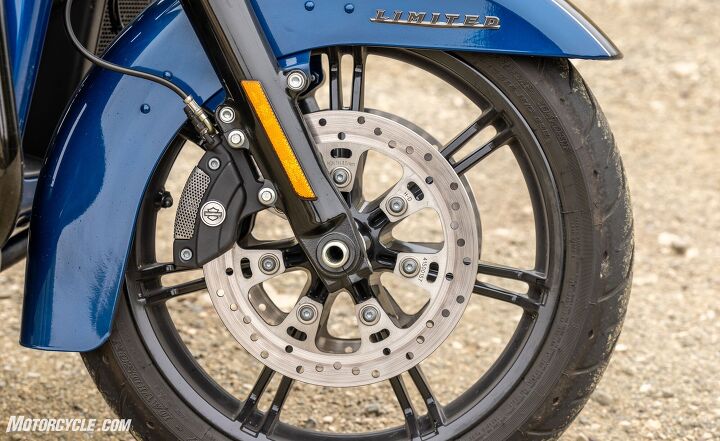
Low-tech next to the Indian, the Harley’s right-side up bending-valve fork and linked brakes get the job done.
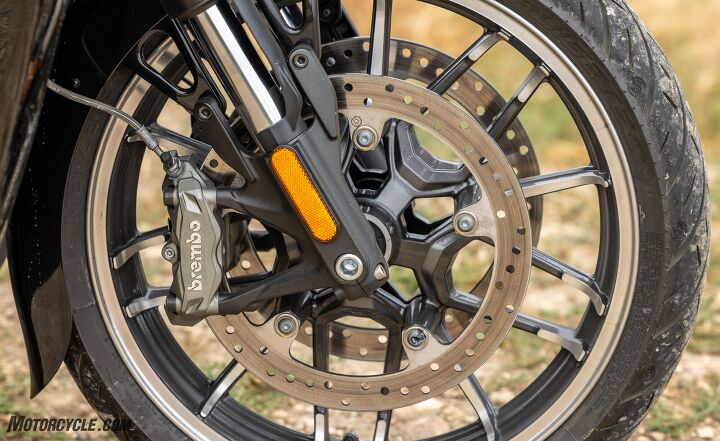
The Indian’s inverted fork gives it a better ride, but those Brembos don’t really stop it any harder than the H-D. Probably a pad thing…
It’s head-scratching how well the Harley works all the time, whether droning the slab or slaying the curves, with its old-fashioned twin shocks out back and their 3 inches of wheel travel. They’re also preload-adjustable, the old-fashioned way. But who’s got time for that?
Maybe we should’ve brought a heavy passenger and more stuff? The 49mm dual bending-valve fork up front does nice work, too, and the whole thing wafts you serenely along.
The Pursuit, though, is even waftier, atop its 5.1 inches of front travel and 4.5 inches out back; the occasional big hit you feel through the Harley’s pillowy seat often goes barely noticed on the Indian.
Our brains were tired by the time we left Parkfield, earthquake center of the world, then made it to our cheap motel in Paso Robles on night one. But our bodies were fine. Chili’s was the only place still open to eat at 9:30 – fine dining for a change!
The Weight
Put the load right on me. No, wait, don’t. The biggest downside of both of these is how heavy they are – right around 930 pounds wet. That’s ok anytime you’re rolling above walking speed, but it can be a PITA anytime you’re not – especially on loose surfaces – and I was relieved to return home after four days without dropping either bike. Turning radii are large, especially the Indian. Careful where you park, because lifting either bike up off the sidestand can sometimes be a Crossfit exercise – particularly if you’ve got a passenger on back. The Harley’s a bit tougher because its seat is higher and its “jiffy stand” has always been weirder.
It’s almost like every other motorcycle manufacturer in the world tries hard to trim weight, but in America we think of more steel as value added. The Harley is 929 lbs wet, the Indian is 933. Honda says its Gold Wing Tour is 843 lbs wet; BMW claims its K1600 Grand America weighs 809 wet – and that’s with seven gallons of fuel. Both of those also offer reverse.
Let me Infotain you
Without big TFT touchscreen displays, we are as nothing. The Indian gives you a 100-watt Premium Audio System with AM/FM, Bluetooth and USB- input RideCommand+, which includes traffic and weather overlays, Apple Carplay, etc.
The Harley’s got more or less the same stuff including four 25-watt speakers. Even the loudest speakers are unintelligible at 80 mph, though, so I kept trying to Bluetooth my Cardo communicator up to both bikes’ stereo tuner, with no success. The Cardo’s six preset stations are mostly useless once you leave your own area. Our Harley came with old-fashioned headsets I suppose you could rig up, with plugs for them in the side of the bike. Seems so 20th century…
Adams thinks: The Road Glide’s Corning Gorilla glass TFT display looks great, but can cause glare in the right light. It seems the H-D’s display processes quite a bit faster than the Indian’s. Pinching and zooming on the map has almost no lag and flipping between screens is instant. There was a noticeable delay in most of the Pursuit’s interfaces whether changing volume with the joystick or navigating settings and displays on its touch screen.
Both stereos, though, are great for treating the kids to Uriah Heep at lower speeds around town or late at night in crowded campgrounds when you need to find people to party with. As for navigation, both bikes do a nice job, but there’s plenty of room for your Butler maps in the trunk too – my favored backup plan. Sadly, we didn’t know Soda Lake Road would go from paved to dirty and sand five miles in. We’re not fans of 900-lb bikes on 40 miles of loose stuff, so we back-tracked.
On day two, we found our way up Highway 101, east on 98, and north on 25 to Hollister, scene of the famous biker rallies back in the day that inspired The Wild One.
Hollister
Brasfield almost started a riot when he asked the ladies tending bar in Johnny’s if they’d turn down the music so we could make our video in the alley. We were lucky to escape with our lives, packing the camera gear in a hurry and beating it outta town to the Salinas Motel 6 for the night.
Backseat riders
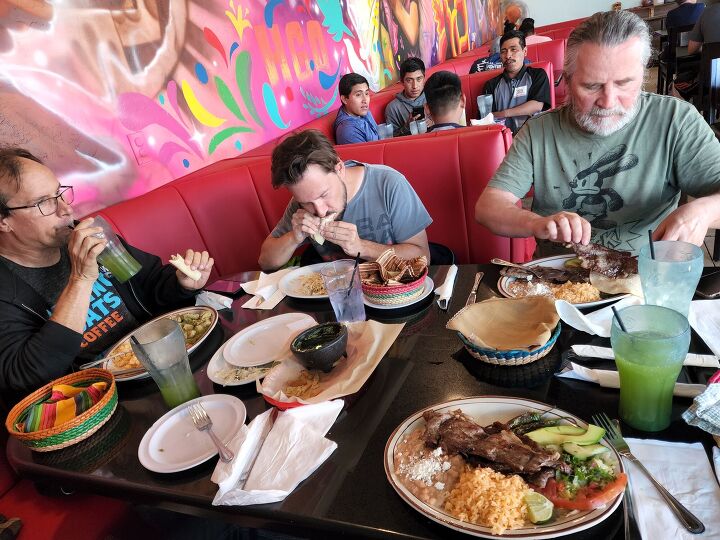
It’s worth staying at the Motel 6 to eat around the corner at Culturas Hidalgo y Oaxaca Restaurant.
Ryan Adams talked Mrs. A into riding and/or sitting on back of both bikes:
I’ve had the Road Glide Limited in my garage for some time now. After being spoiled by the luxurious passenger accommodations of these touring bikes, they’re the only ones my wife has much interest in riding on back of. We were able to do two 100-mile stints together, after which she had no complaints (except for the lack of a heated seat on those cool mornings). She found the passenger riding position completely neutral and spacious, the seat was nice and soft while still being supportive, and she also felt the Harley was easier to jump on and off of.
While we weren’t able to spend any time together on the road with the Indian, she had some initial thoughts just from sitting on the bike in the driveway. Perched on the back of the Indian, she mentioned the entire passenger area was a bit tighter, roomy enough, but more compact than the H-D. She also said she felt her feet, and therefore knees, ended up much higher and that the back and seat cushions felt more firm.
My next door neighbor of the last seven years, Jill, had shown zero interest in any previous motorcycle I’d brought home. But she nearly tore down my garage door wanting a ride on the Harley when I showed up on it. Finally I get it, now that I’m 62. Jill’s 87 I think (don’t tell her I told you). But still hot…
Details…
The Indian’s central electronic locking is nice; the Harley’s old-style barrel locks are simple and foolproof. Both bikes have gloveboxes right and left up front, both with USB outlets in the right side one to charge your phone. The Harley’s are a bit annoying in that they’re spring loaded and want to close on your hand while you’re trying to reach in there. Both bikes have another 12V cigarette plug in the trunk, where you can stash a pair of helmets.
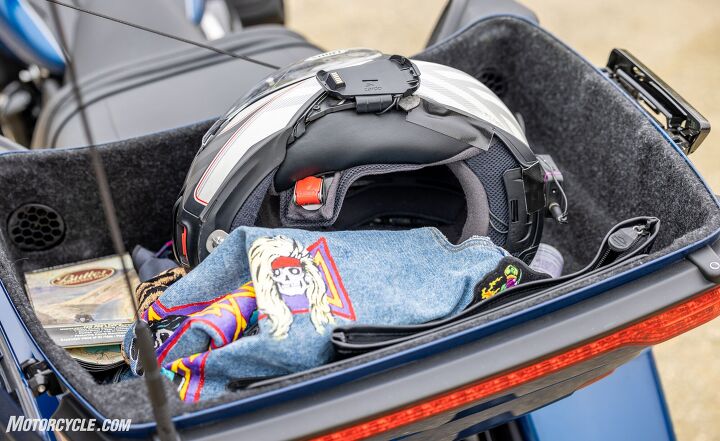
We decided the advantage of the side-hinged trunk is you don’t have to disturb Mama on the back seat.
Ryan says: The Pursuit is packed with features and technology. Some of the things I found myself using most often were the adjustable windshield and the ability to lock the cases with one press of a button on the key fob. Not only can you adjust the electronic Fox shock’s preload from the quick settings screen, you can also go a few steps deeper and adjust actual rider and luggage weights. All this tech makes the Harley feel dated by comparison.
Along with the Fox shock, the Indian’s Premium package gets you the IMU-controlled Smart Lean Technology for ABS and traction control, integrated driving lights, and heated touring comfort seat. The cool seat 2.0 is supposed to be new, improved, and available soon.
Adding the Reflex rider aid package to the Harley adds $1,025 to the $31,874 bottom line of our two-tone with black trim bike, and both motorcycles wind up within spitting distance of $33,000. But you get 930 pounds of motorcycle, so…
Now I get it
I don’t know if the big American V-Twin finally came to me or if I came to it, but seems like it’s a little of both. Indian forced Harley-Davidson to get off its laurels, and Harley-Davidson forced Indian to build significantly better machines if it had any chance of reaching The Base. But now I can see it. If a guy had a week or two off and no particular place to be, either of these is the best way to see the USA since the transcontinental railroad, and both are almost as heavy and stable. You can go faster than 80 on them – though it felt like plenty fast enough when the Indian bumped into its 110-mph governor and the Harley hit its at about 115 indicated. What’s the hurry, bub?
Either bike grants the bearer entry wherever you turn up. The locals will offer you a beer and the ladies will offer you a, well, who knows – but you’re starting off on the right foot when they don’t immediately assume you’re some kind of coastal elite pinhead on a Multistrada or a BMW in a color-coordinated suit, amIright?
A’course, on these bikes you’ll be bringing your significant other along. For a lighter, more carefree solo adventure, you might want to check out the bagger versions of each from 2019:
Bagger Battle: Harley-Davidson Road Glide Special Vs. Indian Challenger Limited
The Winner
Ryan Adams seems to like the Harley:
If I had all the money in the world, I’d love to own a bike like one of these two monsters, but for me it would have to be a third street bike (ADVs and nakeds are first and second for me). With that considered, I would be using it solely for touring, probably two up (and grocery runs, because of the storage and the fact that riding a motorcycle can make the most mundane errands fun). I love the Indian’s PowerPlus engine, and how the bike carries its 933 lbs better overall, but if I’m touring, two-up or not, on this kind of bike, I’m not looking for the rowdiest engine. The Harley, while feeling a bit cumbersome off the side stand or being pushed around the garage, handles itself pretty well as soon as you start rolling. The Road Glide Limited and its rhythmic potato-ing make me feel totally content to just cruise. I don’t mind loping along at reasonable speeds, or even sitting in a bit of traffic. Of course, I wouldn’t complain if the 117 cu. in. Milwaukee-Eight made an appearance for a bit more get-up-and-go when needed. On the Indian however, my lack of self-restraint – and the more frenetic feel of the engine – makes me want to take advantage of the PowerPlus all the time. Despite the Indian eking out a deserved win on my side of the scorecard, sometimes it’s the intangibles that disagree.
The H-D feels really well put together from a fit and finish perspective. All of the touch points exude quality that should be expected from a $33,000 motorcycle. While the Indian has quite a bit more technology and features packed into it, it feels like they had to cut costs in other places which results in some plastic-y feeling bits and general fit and finish in some areas that aren’t quite up to the H-D’s standard.
For me, JB, it has to be the Pursuit. It gets the look down and the wild West vibe, but its performance, modern accouterments, better suspension, and lower seat all leave the H-D in the dust in my book. Also my rebellious streak, the ol’ Oppositional Defiance Disorder, my need to bite the 800-lb gorilla that is H-D.
Harley-Davidson continues to hold a special place in the American heart, apparently. Even though Ryan says he’d rather own the Harley, he’s forced to admit the Indian’s superiority in most categories on the Official MO Scorecard: Combining both our scores tells the tale, It’s the Indian by 3 points, 91.2 to 88.2%. I will fight no more forever. Not for another month or two anyway. There’s a Nightster vs. Scout Rogue showdown soonish…
|
JB In Gear
|
|
Mr. Adams’ In Gear
|
| Scorecard | 2022 Harley-Davidson Road Glide Limited | 2022 Indian Pursuit Limited |
|---|---|---|
| Price | 100% | 99.7% |
| Weight | 100% | 99.6% |
| lb/hp | 75.4% | 100% |
| lb/lb-ft | 89.9% | 100% |
| Total Objective Scores | 94.2% | 99.8% |
| Engine | 83.8% | 95.0% |
| Transmission/Clutch | 82.5% | 90.0% |
| Handling | 93.8% | 90.0% |
| Brakes | 90.0% | 82.5% |
| Suspension | 77.5% | 86.3% |
| Technologies | 91.3% | 95.0% |
| Instruments | 90.0% | 88.8% |
| Ergonomics/Comfort | 97.5% | 97.5% |
| Luggage/Storage | 90.0% | 92.5% |
| Quality, Fit & Finish | 93.8% | 87.5% |
| Cool Factor | 77.5% | 80.0% |
| Grin Factor | 77.5% | 80.0% |
| John’s Subjective Scores | 86.0% | 90.0% |
| Ryan’s Subjective Scores | 87.7% | 88.5% |
| Overall Score | 88.2% | 91.2% |
| Specifications | 2022 Harley-Davidson Road Glide Limited | 2022 Indian Pursuit Limited |
|---|---|---|
| Engine Type | Twin-Cooled Milwaukee-Eight 114 | Liquid-cooled PowerPlus |
| Displacement | 114 ci (1,868 cc) | 108 ci (1,768 cc) |
| Bore x Stroke | 4.016 in. x 4.5 in. (102 mm x 114.3 mm) | 4.251 in. x 3.799 in. (108 mm x 96.5 mm) |
| Compression Ratio | 10.5:1 | 11.0:1 |
| Drive/Driven Clutch | Mechanically actuated 10 plate wet, Assist and Slip | Wet, Multi-Plate, Assist |
| Electronic Fuel Injection System | Electronic Sequential Port Fuel Injection (ESPFI) | Closed loop fuel Injection / 52mm dual bore |
| Exhaust | 2:1:2 dual exhaust with 4 in. tapered mufflers | Split Dual exhaust w/ Resonator |
| Horsepower | 78.4 hp at 4800 rpm (measured) | 104.6 hp at 5600 rpm (measured) |
| Torque | 104.6 lb-ft. at 2900 rpm (measured) | 116.2 lb-ft. at 3500 rpm (measured) |
| Frame | Mild steel; tubular frame, two-piece stamped and welded backbone; cast and forged junctions; twin down tubes; bolt-on rear frame with forged fender supports; MIG welded | Cast aluminum frame |
| Front Suspension | 49mm dual bending valve fork with 4.6 inches of travel | 43mm inverted fork with 5.1 inches of travel |
| Rear Suspension | Premium standard height hand-adjustable rear suspension with 3.0 inches of travel | Fox single shock with hydraulic adjustment and 4.5 inches of travel |
| Front Brakes | Dual four-piston fixed caliper with 300 mm floating discs | Dual four-piston radial-mount calipers and 320mm semi-floating discs |
| Rear Brakes | Single four-piston caliper with 300 mm fixed disc | Single two-piston caliper with 298 mm floating disc |
| Front Wheel | Slicer II cast aluminum with clear coat 18 in. x 3.5 in. | Sport Contrast Cut 19 in. x 3.5 in. |
| Rear Wheel | Slicer II cast aluminum with clear coat 18 in. x 5.0 in. | Sport Contrast Cut 16 in. x 5 in. |
| Front Tire | Dunlop Harley-Davidson Series D408F with bias blackwall; BW 130/70B18 63H | Metzeler Cruisetec 130/60B19 66H |
| Rear Tire | Dunlop Harley-Davidson Series D408F with bias blackwall; BW 180/55B18 80H | Metzeler Cruisetec 180/60R16 80H |
| Fuel Capacity | 6.0 gallons (22.7 l) | 6.0 gallons (22.7 L) |
| Fuel Mileage | 39 mpg (as tested) | 37 mpg (as tested) |
| Ground Clearance | 5.1 in. (130 mm) | 5.4 in (137 mm) |
| GVWR | 1,360 lbs. (617 kg) | 1,385 lbs (628 kg) |
| Wheelbase | 64 in. (1,625 mm) | 65.7 in (1,669 mm) |
| Lean Angle | 32° (left and right) | 31° (left and right) |
| Overall Height | 56.1 in. (1,425 mm) | 56.8 in (1,444 mm) |
| Overall Length | 102.2 in. (2,595 mm) | 102.7 in / 2609 mm |
| Overall Width | 36.6 in. (930 mm) | 39 in (990 mm) |
| Rake/Trail | 26° / 6.7 inches (170 mm) | 25° / 5.9 inches (150 mm) |
| Seat Height | 28.9 in (735 mm) | 26.5 in (672 mm) |
| Weight | 929 pounds (as measured) | 933 pounds (as measured) |
| Color/graphics | Vivid Black (Chrome Finish), Mineral Green Metallic (Chrome Finish), Gauntlet Gray Metallic/Vivid Black (Chrome Finish), Vivid Black (Black Finish), Gunship Gray (Black Finish), Reef Blue/Vivid Black (Black Finish) | Black Metallic, Deepwater Metallic, Maroon Metallic/Crimson Metallic |
| Factory Warranty | 24 months (unlimited mileage) | 2 Years, Unlimited Miles |
| Gauges | Gauges styled to complement each vehicle. Display features odometer, trip A, trip B, range to empty and gear indicator; and larger tell-tale indicators. | Fairing-mounted instrument cluster featuring analog speedometer and tachometer with fuel gauge, range, odometer and current gear. 15 LED telltale indicators; cruise control enabled, cruise control set, neutral, high beam, turn signal, ABS, check engine, low tire pressure, battery, low fuel, security system, low engine oil pressure and MPH or km/h unit designation. |
| Lights | LED lighting including LED 40-watt, 1,060 lumen low beam, 60-watt, 1,560 lumen high beam headlight | LED lighting including Pathfinder LED Headlamp |
| Standard Equipment | Boom! Box GTS audio system with GPS and touchscreen | 7 in touchscreen powered by RIDE COMMAND with Navigation and Apple CarPlay integration; Selectable Ride Modes; Rear Cylinder Deactivation; Cruise Control; Tire Pressure Monitoring; Remote-locking Hard Saddlebags & Trunk; 35.8 gallons of Storage; Highway Bars; Adjustable Passenger Floorboards; Brembo brakes; 18+ Gallons of storage; ABS: Keyless Ignition; Chassis Mounted Fairing; Power Windshield; Adjustable Fairing Air Flow Vents; Heated Grips; 200 Watt Audio System with AM/FM, Bluetooth, USB, Smartphone Compatible Input, and Weatherband; 12V Charging Port |
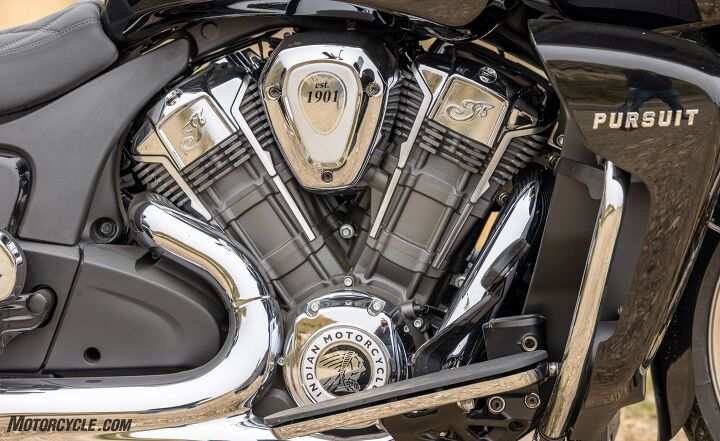
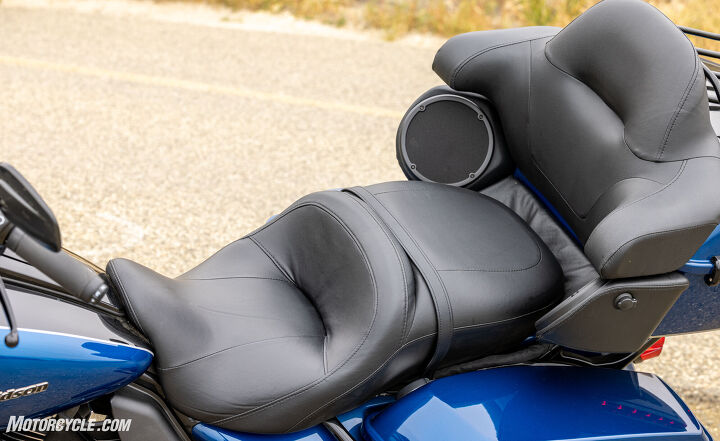
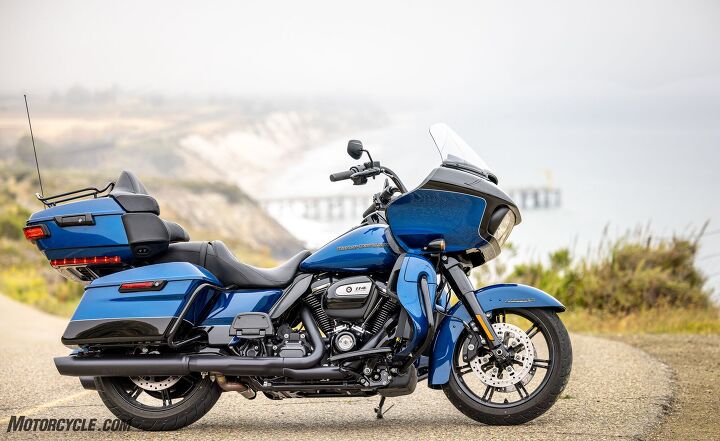
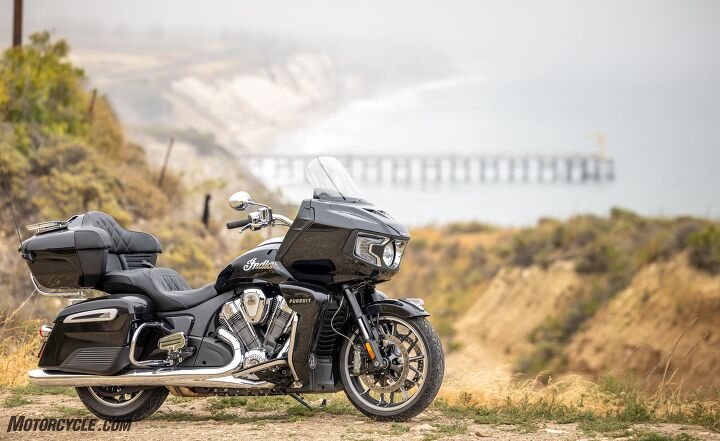
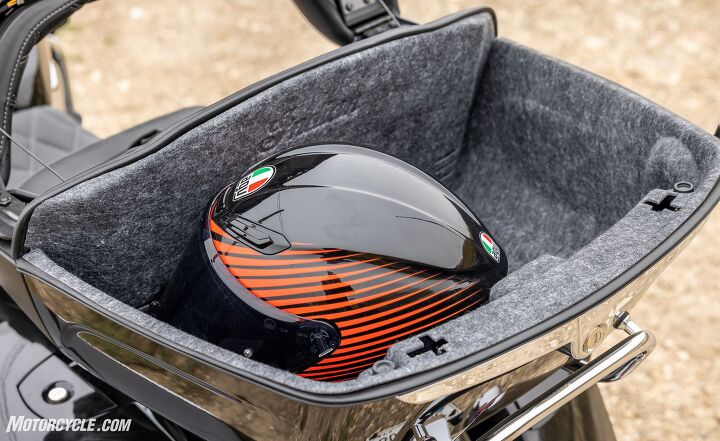
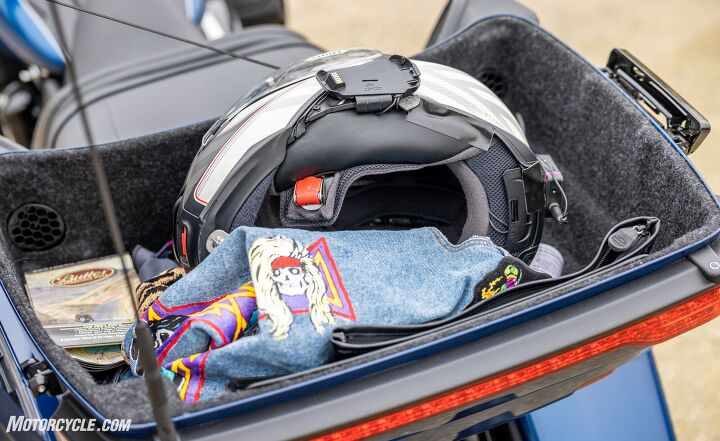
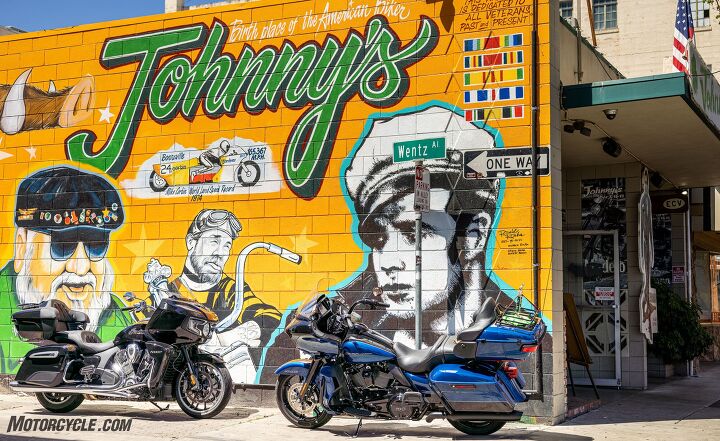
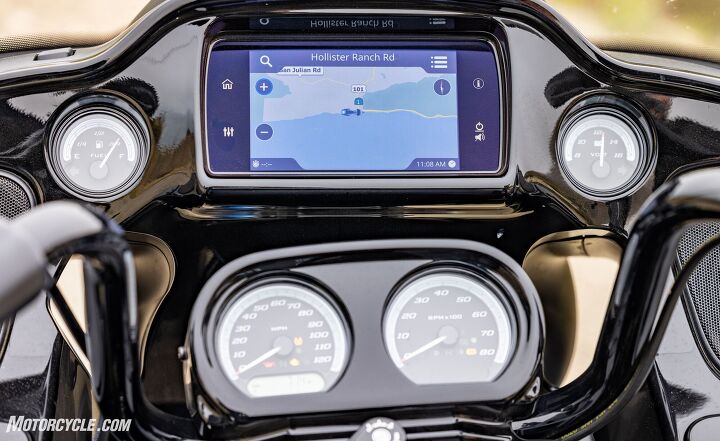
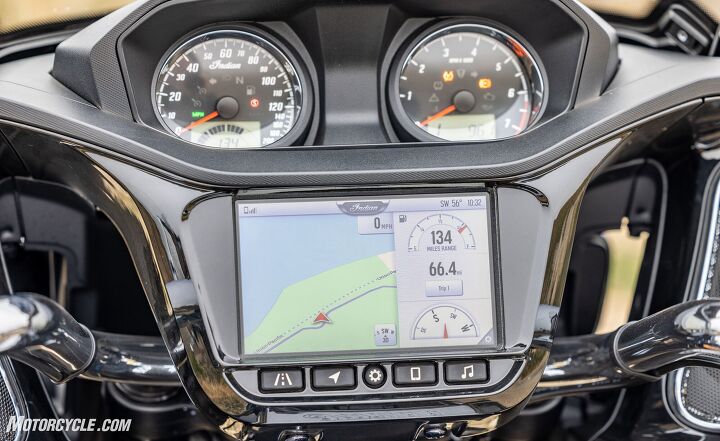
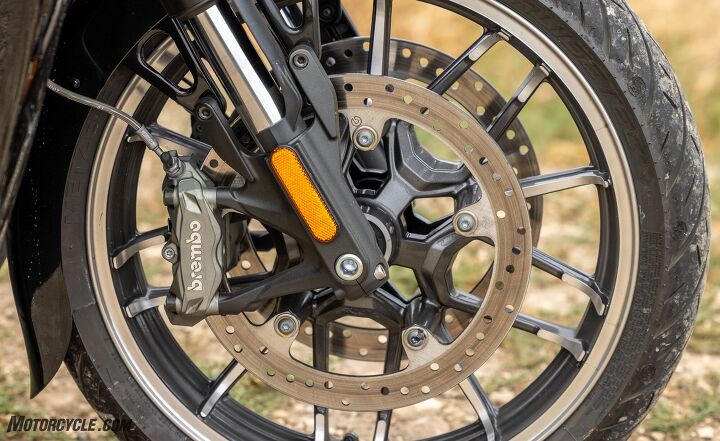

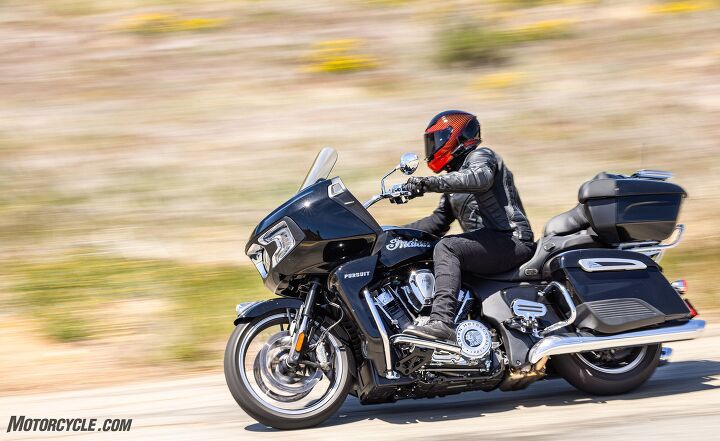
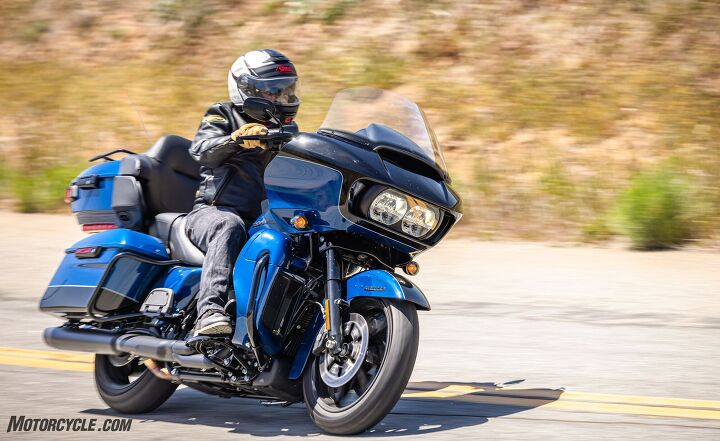
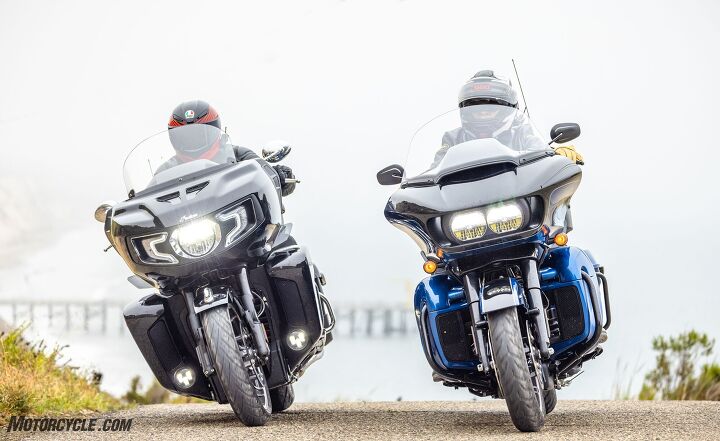
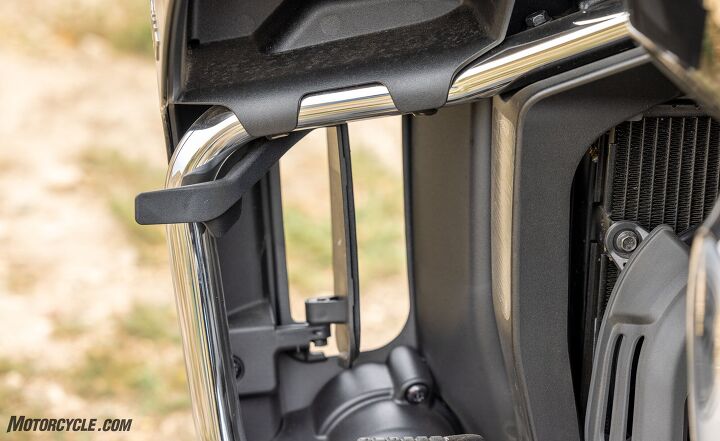
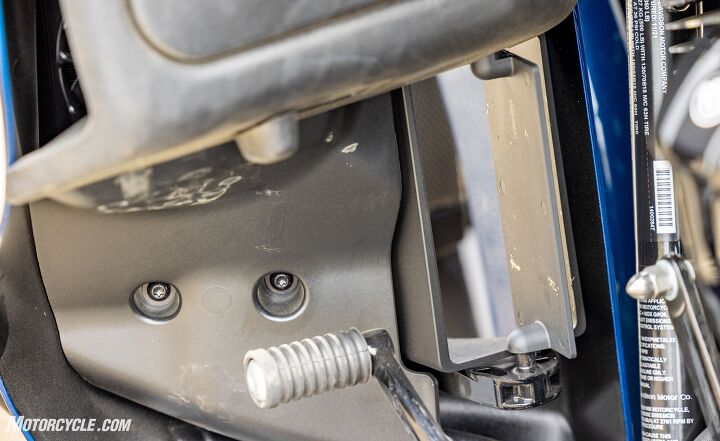
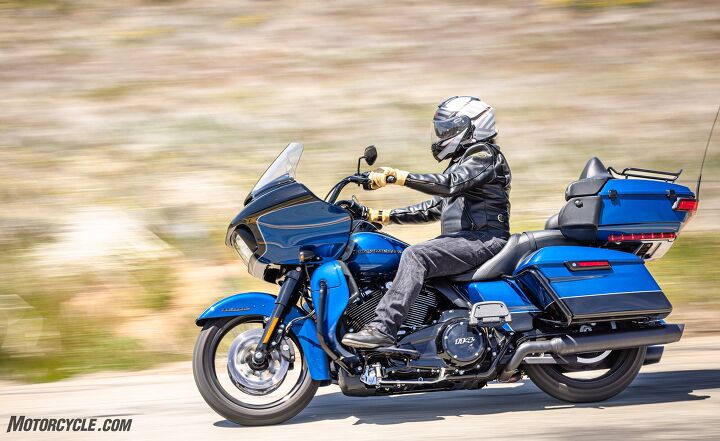
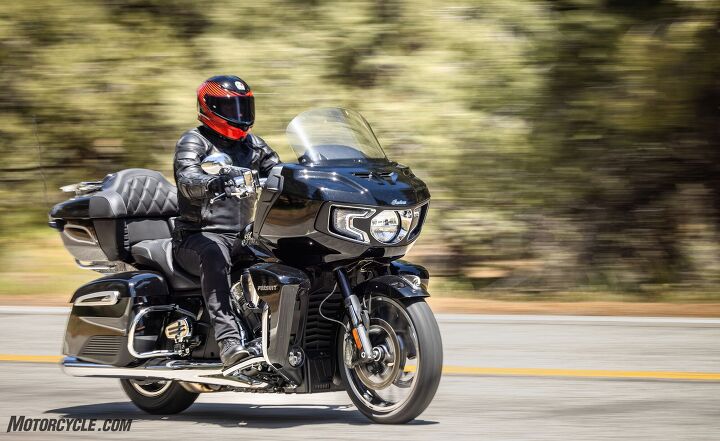
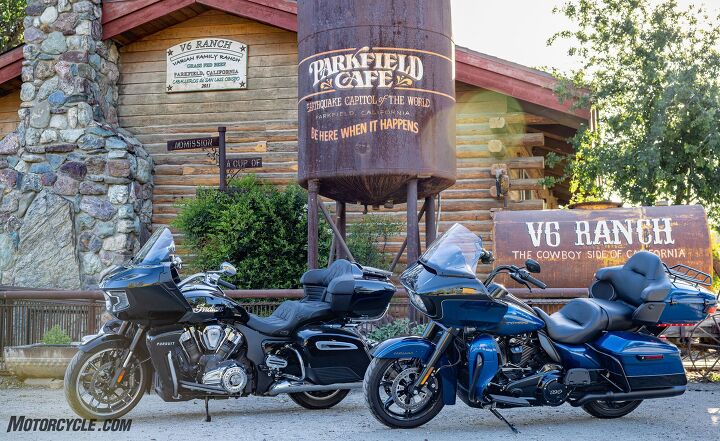
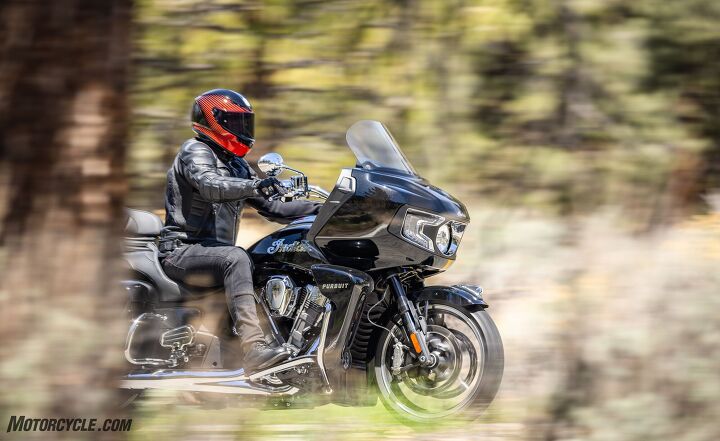
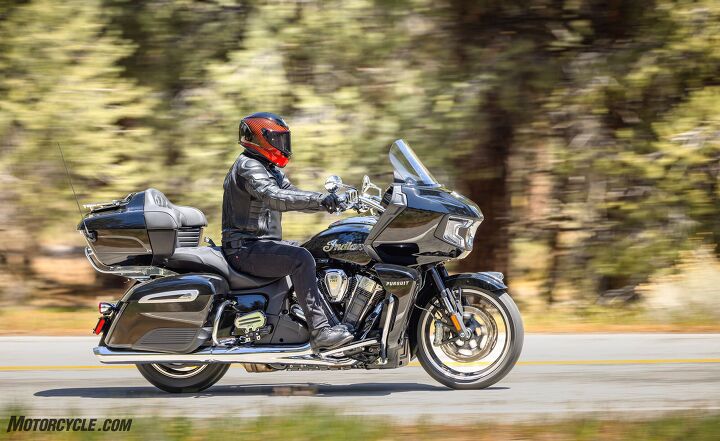
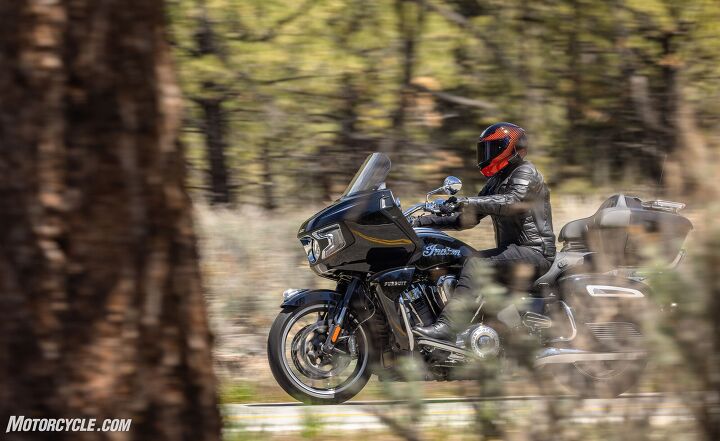
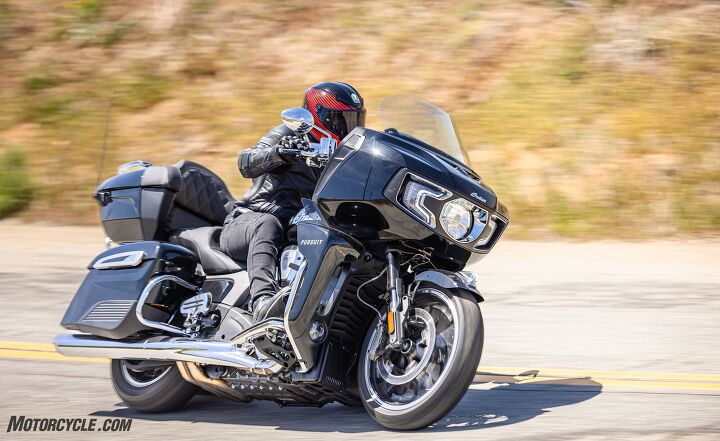
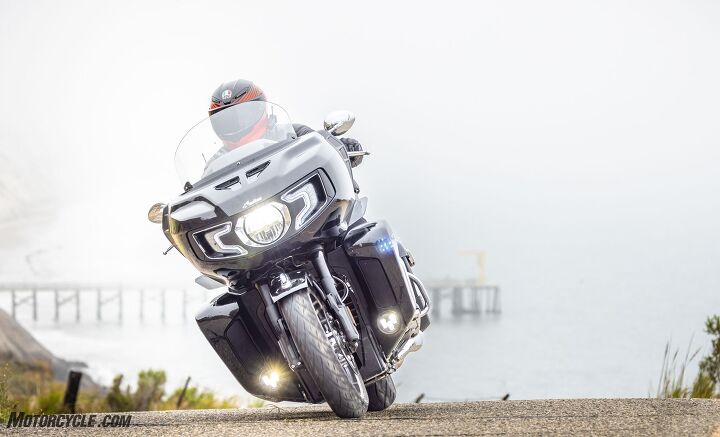
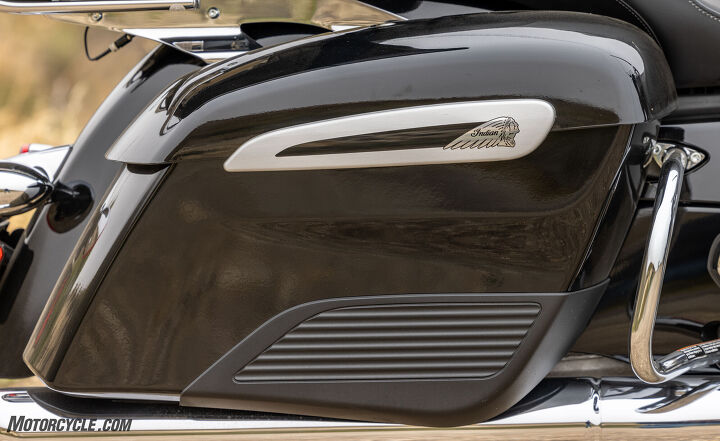
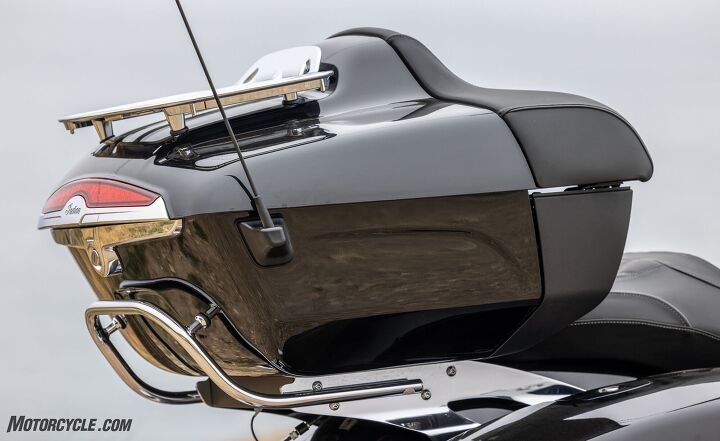
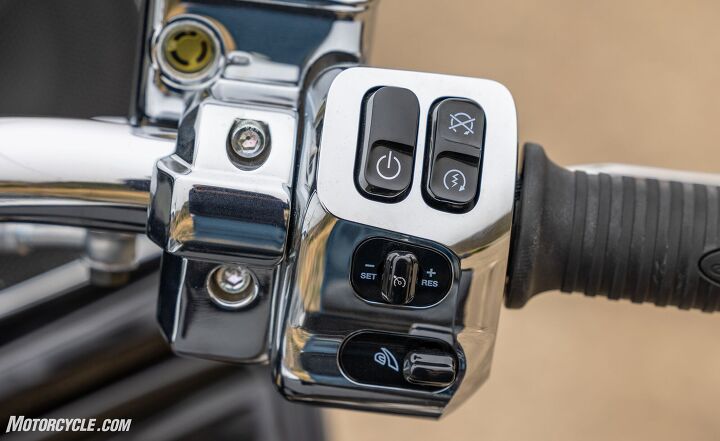
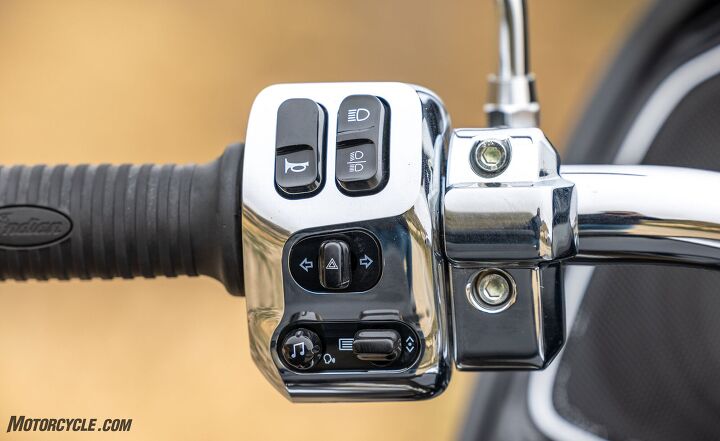
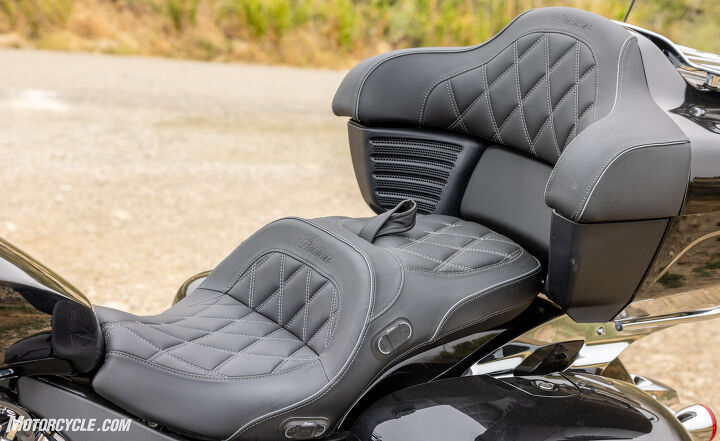
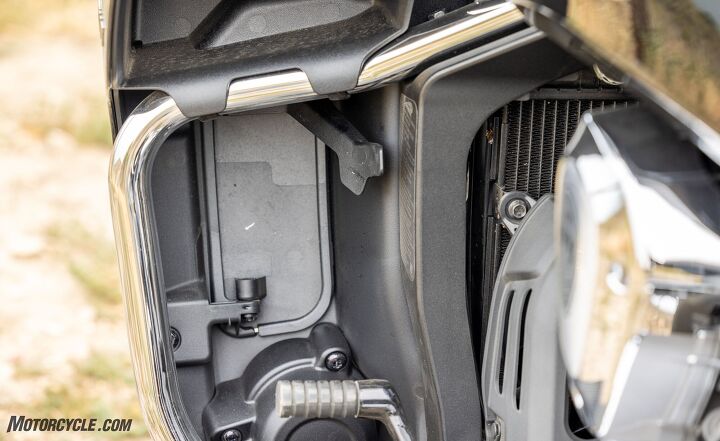
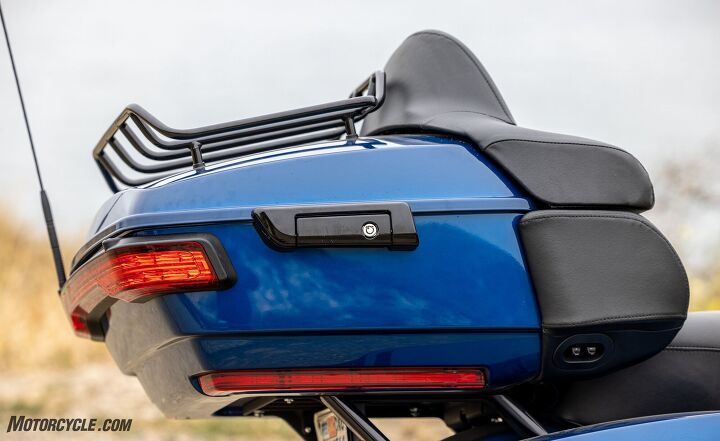
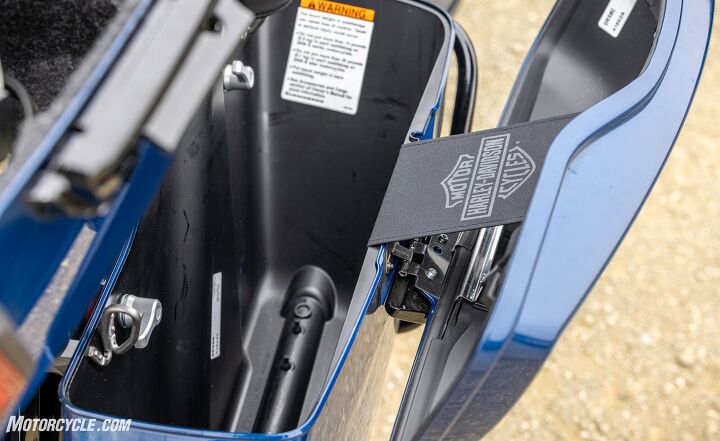
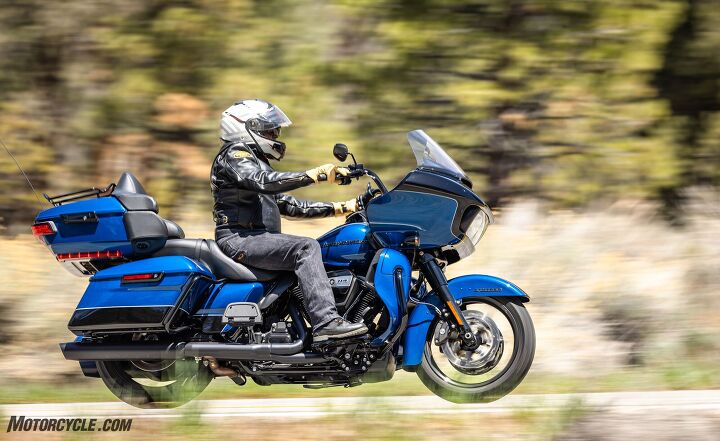
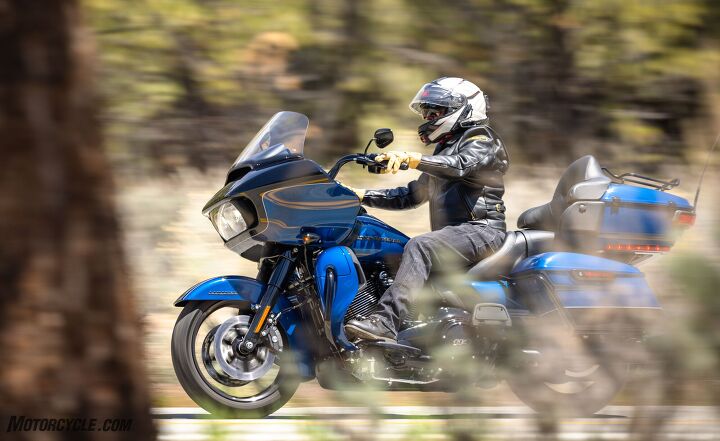
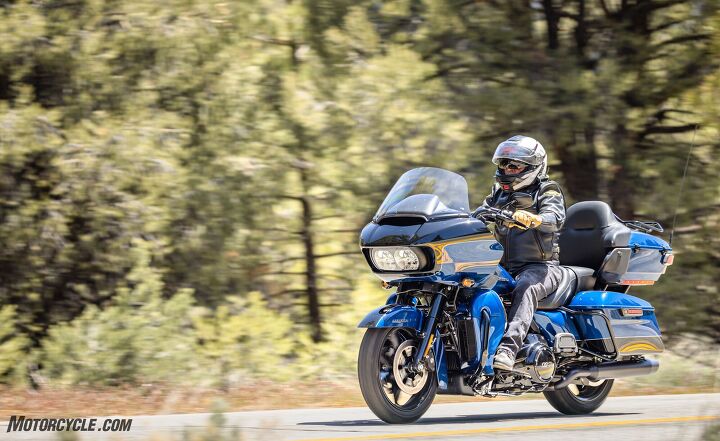
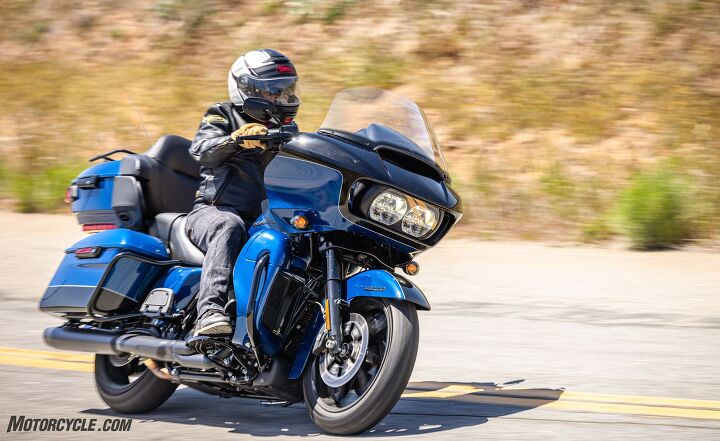
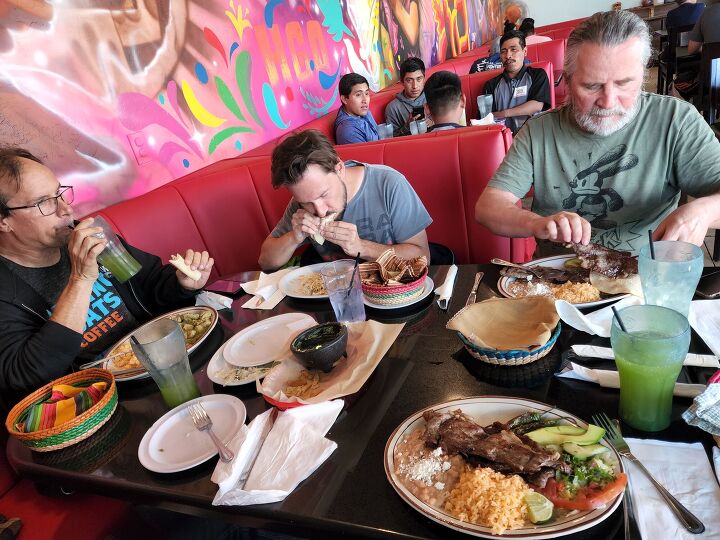
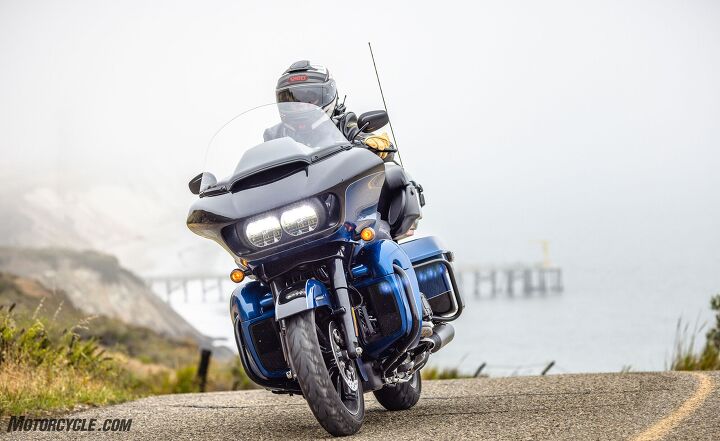
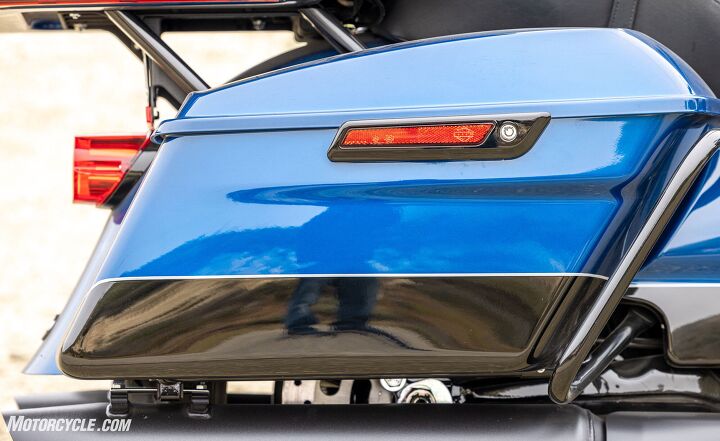
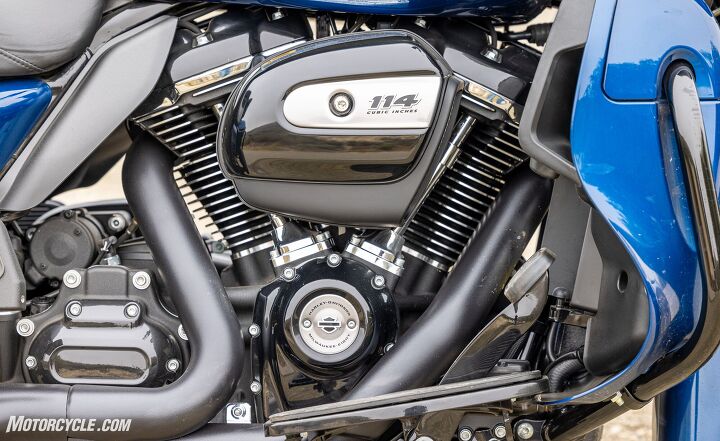
We are committed to finding, researching, and recommending the best products. We earn commissions from purchases you make using the retail links in our product reviews. Learn more about how this works.
Become a Motorcycle.com insider. Get the latest motorcycle news first by subscribing to our newsletter here.
The post Showdown: 2022 Harley-Davidson Road Glide Limited vs Indian Pursuit Limited Premium appeared first on Motorcycle.com.
Copyright
© Motorcycle.com


